I have often heaped scorn on adults who still read comic books and watch movies based thereon, but as with all things, there are exceptions to this.
One of them is the peerless Asterix series of comic books, created by the now-deceased French writer/illustrator team of Rene Goscinny and Alberto Uderzo, translated into English (and improved) by the late Anthea Bell and Derek Hockridge. (I’ve read them in both French and English, and the English ones are funnier to Anglophones because the French dialog often references obscure French customs and idioms.)
The reason that the Asterix books are so funny is that while on a superficial level, the story is aimed at children and can be enjoyed by them (Gauls beating up Romans, and the hero Asterix getting involved in all sorts of escapades), the real humor is in the writing. This is not child’s play at all, because one needs a real knowledge of Latin, some Greek, and huge dollops of classical history for much of it to make sense. (Older TV cartoons — Bugs Bunny, Mickey Mouse etc. — are similar in that while there’s a lot for kids to enjoy, the humor is often very adult, in the traditional sense.)
What often causes me to break out in howls of uncontrollable laughter are the names: the Gauls (Asterix, Obelix, Cacafonix the bard, Impedimenta the chief’s wife, Unhygenix the fishmonger and his wife Bacteria, Postaldistrix the mailman, etc.), the Romans (Spurius Brontosaurus, Gluteus Maximus, Surplus Dairyprodus, Crismusbonus, Dubious Status, Nefarious Purpus, etc.) as well as other nationalities (Ekonomikrisis the Greek/Phoenician, Wotzisnehm the Indian fakir, Mykingdomforanos the British chieftain, Edifis the Egyptian architect, etc.).
Likewise, Uderzo’s depictions of all these characters are wonderful: full of expression and action, they make the Marvel-type of cartoon drawing look like the work of children. Here are just a few examples:
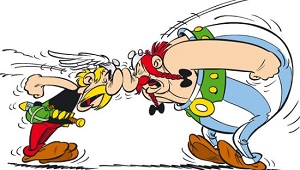

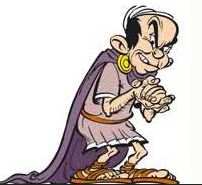
And then there are the ladies:
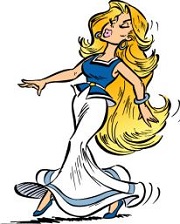


But they all pale into insignificance when there’s fighting:
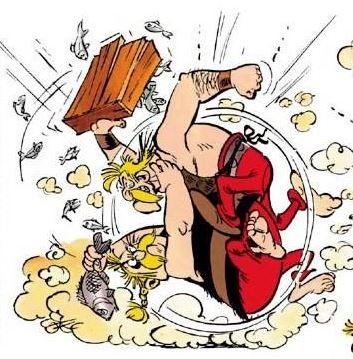
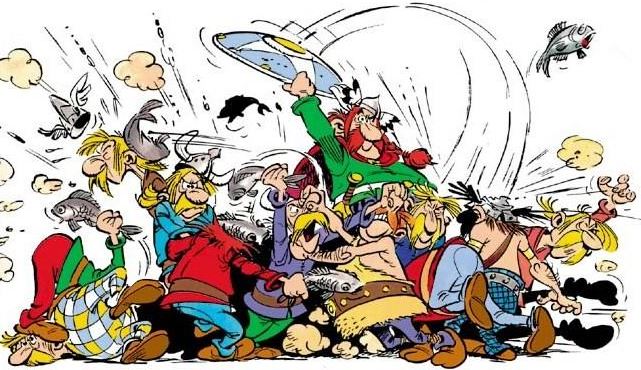
And cultural differences are always a source of entertainment, whether it’s just beer:
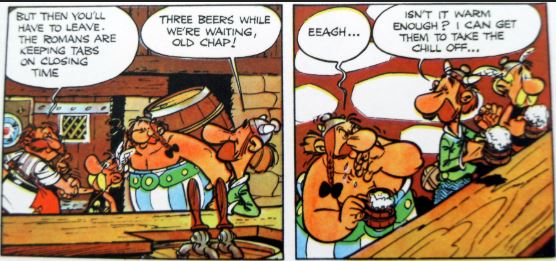
…sexism:

…a Roman orgy:
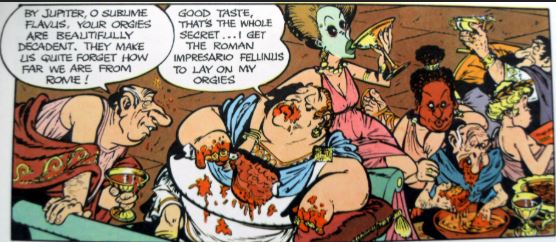
…or just a sly dig, so to speak:

…and occasionally, there are some guest appearances:
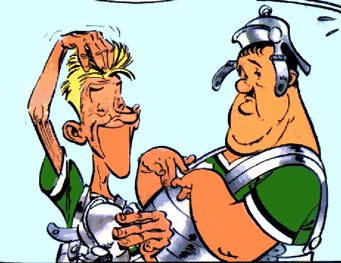
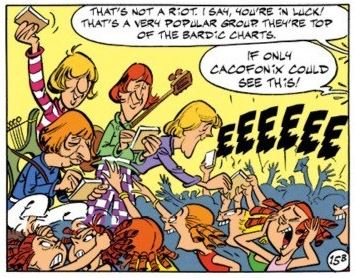
I could go on all day about this wonderful creation, but there’s a decent Wikipedia entry (for a change).
I’ve read the first twenty-four (the “true” Asterix books) in the series, and maybe a couple of others. I have only a few in my library, because they’re expensive when bought Over Here. But to re-read them is a very definite item on Ye Olde Buckette Lyste.
Oh, and to bring this all (very) up to date: in Asterix And The Chariot Race (published in 2017), Asterix’s main competitor is named… Coronavirus.

Ahh! Thanks for reviving old memories. Grew up reading Asterix and TinTin both in French and Spanish. I think I have read all of the originals but sadly none survived my moves around the globe. I did introduce my children to the genre with a couple in English, so there is that.
Did not know that they were being maintained after the passing of the original author and illustrator, going to have to look into that, after all, there are now grandchildren to influence and give the right mindset to. Knowing when not to respect authority is a carefully crafted skill.
It was also chockfull of little details that revealed the minds of the creators. On Asterix goes to Rome (Or conquers Rome) there is a panel where they walk in front of Caesar’s house. On the gate there is this small sign in Latin that reads “Cave Canis” (Beware of the dog). I think I laughed for a full minute on the sheer smart silliness of that joke.
Oh, does this bring back memories. Way back in early 19-ought-73, I was living in Stuttgart and one of the guys I was living with had (IIRC) 20 issues of “Asterix der Galier” in German. My German was pretty good at the time, but I sure picked up a lot of useful idioms.
My two favorite issues were the one with Cleopatra (“So eine hübsche Nase”) and the one where Magifix nails the Romans with a potion that promotes extreme hair growth.
The old cartoons are great. As my brother says, they have slapstick for the kids, and all sorts of inside jokes and puns, visual and verbal for the adults, so Dad could be sitting laughing at the same cartoon as junior, and it became a bonding experience, to use an overused term. The Smurf cartoons just aren’t as good. Compared to the story lines of the old cartoons, they are like Clutch Cargo versus Pinocchio or Snow White.
I discovered Asterix and Obelix in Austria, and found another over here in Alpine Village in So Cal. They are expensive over here. I have, and lovingly remember Asterix bei die Normannen (Asterix with the Normans) and Asterix in die Schweiz (Asterix in Switzerland). That last is memorable because Asterix needs an edelweiss for his magic strength drink, and somehow Obelix is out cold for 90% of the trip through the mountains and had to be dragged everywhere like a giant log. When he was asked at the end how Switzerland was, Obelix replied, “flat”.
Wonderfull
I always enjoyed the Asterix books growing up. My father had a couple of them, one survived and should be around here some place.
Another “Adult” Cartoon to look into is Stan Lynde’s “Rick O’Shay and Hipshot Precussion”. I read those for as long as they were in the “Funny Pages” and damn near cried when they were dropped (for Broom Hilda as I recall).
The, actual living, Governor of Montana offered a Full Pardon for any crimes commented by Hipshot during one episode when he had been shot. It started off rather simple then over the years evolved to much better rather along the “Asterix” style.
As I sit here and type this I have two signed prints on the wall in front of me.
http://stanlynde.net/rick-oshay-prints_267.html
Thanks for your site.
The Asterix series is great. I’ve got copies in English, French (when I was learning French for work, these were quite useful), and even one in Latin. I’ve read somewhere that in France, the Asterix books were the only comics considered appropriate for adults to be seen reading. Tintin was also good, but had more realistic scenarios. And, it turns out, Goscinny also worked on another strip called “Iznogoud” (in English, at least) that is almost as good as the Asterix series. The punny names are as good, for sure.
From the Wikipedia entry, “The comic series chronicles the life of Iznogoud, the Grand Vizier of the Caliph of Baghdad at an undefined period in the past. His greatest desire is to replace the Caliph, leading him to repeatedly utter the phrase “I want to be Caliph in the place of the Caliph” (dethrone him), a phrase that has been adopted in certain European languages to characterize overly ambitious people. Iznogoud is supported by his faithful servant, Wa’at Alahf.”
Great post, great comments.
I got into Asterix when my two sons were in French immersion school. I was forced to tune up my much decayed French, but enjoyed it because these cartoons were so well done, so clever.
Quite an achievement to write cleverly illustrated, historically mostly accurate stories with multiple levels of jokes. In school I hated history, and learned very little, but these things got me reading lots of European history just to keep up with my sons and the story line.
That historical reading turned into a travel addiction – I’ve seen Roman museums, ruins and artifacts in Italy, Spain, Portugal, France, Germany, Austria, Hungary and Czechia and the UK. More to come if the corona-fascists ever let me travel again.
Now I’ve got to go dig through the boxes of our kids stuff, hoarded by my wife, to see if we still have Asterix.
Yer welcome.
Ah, Asterix. Many fond memories.
Loved the Egyptian Ptenisnet.
Great name, excellent character.
The translators were also very good at translating the punny names. I noticed, for example, that Obelix’s dog’s name in English was “Dogmatix”, and in French “Idéfix”. I also forgot to mention in my earlier comment that I also like the “Rick O’Shay” comics. The other really good American comics were “Pogo” and “Steve Canyon”. “Steve Canyon” was more aimed at an adult audience (not much there for the kiddos), but “Pogo” was another that worked on both levels – funny for the kids and a different level of funny for the adults.
Pogo was very good and don’t forget Li’l Abner from Dogpatch.